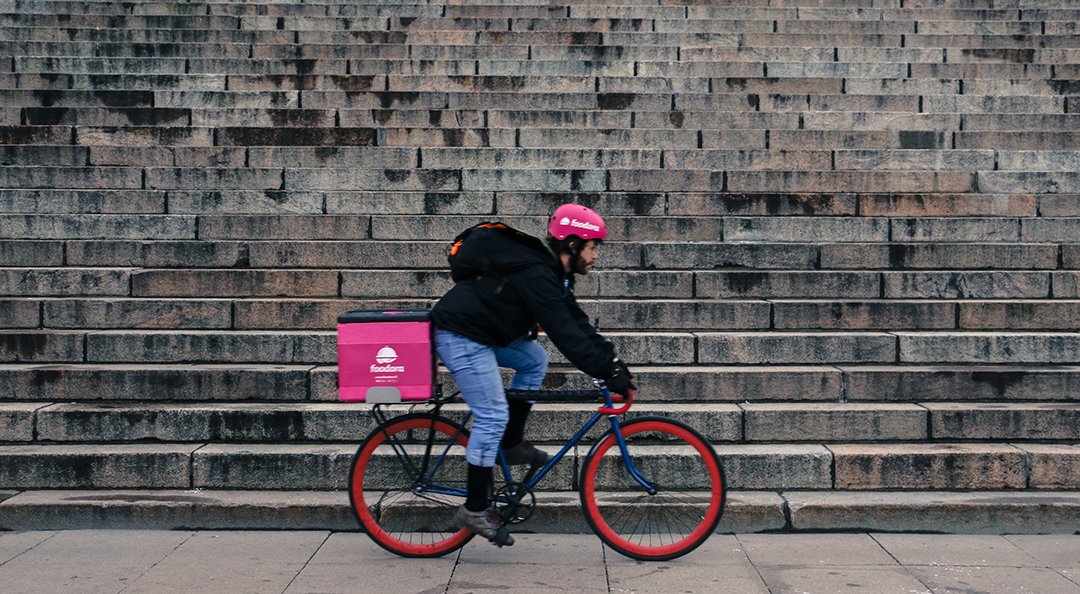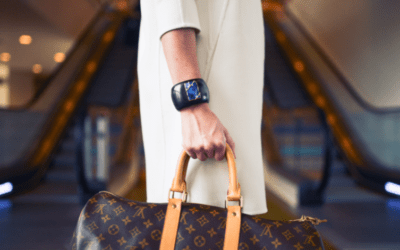We’ve brought you stories about the world of culinary trends, from the history of the Michelin guide to the global boom in food truck culture to the rise of on-call personal chefs through today’s sharing economy. But there’s a trend today that’s truly changing the way we eat, or at least trying to, judging by the sheer number of companies tapping into the market. As food delivery companies like the U.S.-based Grubhub and UberEATS, U.K.-based Deliveroo, Germany-based Foodora, and Switzerland’s Smood continue to proliferate and to grow in popularity among consumers, more and more restaurants – from the corner pizza joint to the gastronomic destination – are jumping on the delivery bandwagon in order to increase sales and satisfy customers who prefer to take the dining out experience into their living room.
What is the food delivery trend?

Food delivery companies that effectively act as middlemen between the restaurant and the consumer, fueled by a smartphone app or web page, are growing in major cities around the world. Grubhub, founded in 2004 by two web developers looking for an alternative to paper take-out menus, was the first example of this now global trend. Although there was nothing new about getting food delivered to your doorstep with the help of a website in 2004 – pizza companies and grocery stores had already been doing it – it was in 2014 that Grubhub started to deliver food from restaurants that did not operate delivery services themselves, thereby truly offering something to consumers that they couldn’t get before: freshly prepared food from their favorite restaurants, enjoyed at home. For many Netflix- and sofa-loving consumers, this was the very definition of “having it all.”
And in a time when “fresh” is a successful marketing buzz word, these companies have an advantage: what could be fresher than daily chef-prepared cuisine, delivered in minutes?
It’s the premise on which Switzerland’s Smood – an amalgam of “smart” and “food” – was founded. Its CEO, Marc Aeschlimann, points out that although the concept of fast food delivery is not necessarily new, the concept of delivering high quality, high-end food is now a global craze, and it’s why Smood has had success in Switzerland since launching in 2013.

“Our revenue is shared between organic, healthy and high-end food,” he says, noting that the market for high-end delivery in Switzerland is very fertile for two specific reasons. “People here travel a lot, and so they were aware that this kind of service existed elsewhere already. When they saw it came to Switzerland, we had a lot of remarks like ‘finally!’,” he says, and adds that the large amount of restaurants in the Swiss market has contributed to the company’s success, as the restaurants are trying to stand out amongst the lot. “In addition, food delivery generally focuses on the city center and our delivery service allows us to reach customers based outside of the city center.”
Julian Dames, Chief Marketing Officer and co-founder of Foodora, based in Berlin, says that he feels the rising global demand for high-end food delivery is the result of the combined success of two other recent movements. “On the one hand, you have an increasing appreciation for food, a demand for higher food quality and a rise in ‘conscious eating,’” he points out. “And on the other, you have an increasing need for convenience and things that are available at your fingertips, with the help of apps.”
How it works
According to Aeschlimann, the business model that Smood is founded on – proposing delivery services to restaurants that do not deliver themselves – provides a way for restaurants to increase their revenue without touching their profits. “When a customer places an order through our delivery service, the restaurant’s operating expenses are not applicable,” he says, explaining that usually a price is divided into thirds: one third food cost, one third operating expenses, and one third profit. “We take one third of the value of each order, which is normally used to pay the operating expenses.” Smood currently has 25 administrative employees and its delivery employees are a mix of both freelance and full-time staff, which Aeshlimann says allows the company to respond to demand as it evolves.

Foodora, a food delivery company operating on a much larger scale with over 7’000 restaurant partners globally across 10 countries, works similarly, but replacing the car and driver with a bike and rider, in most cases. Food from local restaurants is ordered via the Foodora app and delivered by bike or moped, depending on city and neighborhood. “We take care of the logistics, so we partner with the restaurants that would not usually deliver and offer a higher quality of food,” says Dames. The fact that we do it ourselves enables us to work with the restaurants we choose and to offer our customers a much higher standard of food.”
Although Dames would not disclose Foodora’s exact commission structure, he says that the company takes a commission per order, paid 100 percent by the restaurant, and a delivery fee, paid 100 percent by the client. Like Smood, Foodora works with a mix of employee riders and freelance riders. “It depends on the markets and on the local legislation,” says Dames. “In the German market, for example, a big part of them are full-time with salaries. In other markets, we operate on a freelancing model.” Foodora currently has a total of 7’500 riders globally.
Deliveroo, the company that is currently dominating the U.K. market with expected 2016 revenues of £130 million, also defines its delivery riders as “independent contractors” and has experimented with both a fixed hourly rate for its riders and a per-delivery pay model.

When demand is high, both models can be successful, but when delivery riders do not receive jobs over a stretch of a few hours while being paid an hourly rate, profitability can dive quickly. This is where UberEATS, the industry’s newest player, on the scene in central London since June 2016, may come out on top. Its business model effectively “piggybacks” off already working Uber drivers. When they don’t have a ride, they can deliver food, helping to eliminate the expensive “down time” that plagues other food delivery companies paying hourly wages.
The technology

In an industry with so much competition, it is notable that what may eventually set these companies apart has nothing to do with food, really. It’s all about technology. Both Deliveroo and Foodora claim that their algorithms will allow them to get ahead in what the industry calls UTRs: rider utilization, or absence of the rider “down time” mentioned above. In an August 2016 interview with TechCrunch, Deliveroo’s UK Managing Director, Dan Warne, said, “The opportunity for [drivers] to earn more money is going to come from Deliveroo’s ability to develop stronger algorithms and better technology so that they can do more in shorter periods of time. There’s a massive, enormous opportunity for us to do that.” Likewise, Dames says, “Foodora’s algorithms and technology are very smart, very advanced. It’s safe to assume that we currently have the strongest UTRs in the market.”
And the companies’ UTRs are indeed key to their profitability. Just ask “Take Eat Easy,” a Belgium-based delivery company that shut down over the summer of 2016, with a business model quite similar to Deliveroo’s, according to the Telegraph. Its CEO, Adrien Roose, in a statement assessing the company’s failure, said that UTR is the main source of profitability in this business and that “…a low courier utilization [UTR] implies a negative contribution margin.” Essentially, revenues did not exceed costs.
According to a Maddyness article published in August 2016, none of the major food delivery companies is profitable for this exact reason – the cost of delivery is just too high. So why do investors keep injecting money into the sector? If the technology keeps advancing, eventually one of the companies will pull ahead and discover a way to be profitable, and investors are betting on that when they invest.
How to control quality

Detractors of this business model may point out that one of the basic principles of dining out is enjoying the service—the treat of having someone friendly and knowledgeable take your order, deliver your food and tend to your every need throughout the meal. Your steak is not cooked properly? The server takes it back to the kitchen. Your server was rude? You can speak instantly to the manager. This is especially true at high-end restaurants and gastronomic destinations, so how do companies delivering their products maintain the quality that their clients have come to expect?
For one thing, consumers who order food online for home delivery know they will not have the same kind of tableside service they would get at the restaurant—it could be the very reason they order in, to avoid the interaction. And Aeschlimann says that it is important not to confound a driver with a waiter. “We impose our logistics on the drivers,” he says. “So we do not hire a driver, we hire a logistics process.” This means training the drivers and ensuring the use of cooling or heating boxes during the delivery process. In addition, regular quality checks ensure that the delivery process is followed. “We have one person who surveys quality by walking around near the restaurants and [delivery areas] to watch the driver, how they act, etc.”
Both Aeschlimann and Dames also point out that knowing what kind of food travels well and what doesn’t is one of the most important ways to ensure quality of the product and of customer experience. Dames says that his team has advised restaurants to take certain things off the menu, and Aeschlimann notes, “We refused a Japanese restaurant that wanted to do a Japanese fondu, and same with a restaurant that wanted to serve a côte de boeuf. We only deliver the things we can master.”

For many delivery consumers, the quality of their experience depends mainly on the delivery time promise. The faster the delivery, the fresher the food. Dames notes that for Foodora clients, the most important thing is what he calls “bag time” – the amount of time the food is actually in the delivery bag. “On average it should not be more than 10 minutes. For a delivery time of 30-35 minutes, most of this is prep time in the restaurants,” he says. “Lastly, the [delivery riders] do receive training to make sure they handle the food correctly.”
Getting restaurants on board

While convincing consumers to order fresh, high-end delivery food online does not seem to be a challenge in today’s smartphone-driven economy, convincing traditional restaurants to allow their food to be delivered by a third party is a different story. Aeschlimann says that for Smood, the kind of contract that it offers its restaurant partners makes them want to try the service. Add to that the fact that Smood covers the cost of the photography, which Aeschlimann says is a major success factor of restaurants on the site. “We work together and our collective interest is to earn money. It’s a partnership and it’s totally free for [the restaurants].” he says. “As long as both parties are happy, we continue to work together. The restaurants are free to end the contract at any time, which is very important to build trust with our partners, as they know that they will not be trapped by a contract.”
Dames says that when Foodora started, it was very much about educating potential restaurant partners and making them aware of the demand. “We had to make them understand that we were actually able to deliver the quality,” he says. “It was a lot of test orders, getting packaging right, etc. Now that we are more established, it is easier. Restaurants talk to each other, and we have established trust now, so it’s easier for us to convince partners to work with us.”

Where is the trend heading next? Deliveroo has begun investing in its own kitchen space in London with the launch of Roobox. The idea is to provide fully equipped, off-site kitchen space to restaurants in order to expand delivery areas. It solves the problem of expansion into areas where there is a large population of willing residents (demand) but a small concentration of restaurants (supply). Moreover, it removes a bit of the risk factor for chefs who may be talented but not business-savvy. Deliveroo CEO and co-founder, Will Shu, told the Guardian recently, “Traditionally, expanding a restaurant business comes at significant risk, and substantial cost to small businesses. RooBox frees small business owners from this, enabling them to test locations through a delivery-only offering, while simultaneously growing their customer base, revenue and brand in new areas.”
As for Foodora’s future plans, Dames remains a bit secretive, but says, “We have a lot of things in the pipeline—additions to the business model, helping restaurants with support and enabling kitchens, a lot of ideas going around!”
What’s clear is that there is a lot of room for growth within the online food delivery business, and a lot of companies and investors who want to capitalize on that potential. In May 2015, a TechCrunch article reported that while the takeout and delivery industry itself is worth $70 billion, online orders account for just $9 billion, a fact which actually points to industry under-saturation, despite the multiple companies trying to join the scene. What does it all mean? There is a lot of competition out there, and the race is on to provide better rider utilization, offer niche services and effectively bring the restaurant into our daily home routine.




